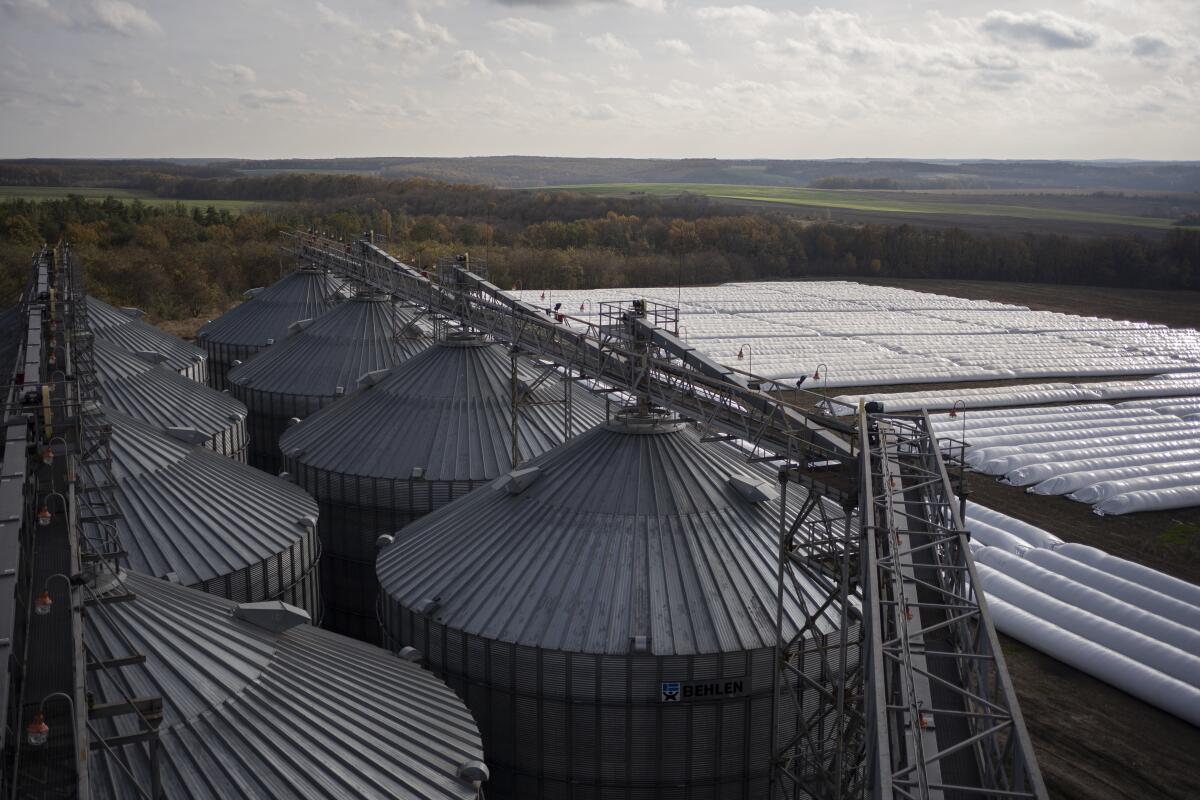Ukraine is shipping more grain through the Black Sea despite Russian threats

- Share via
KYIV, Ukraine — Grain thunders into rail cars and trucks zip around a storage facility in central Ukraine, a place that growing numbers of companies have turned to as they struggle to export their foodstuffs to people facing hunger around the world.
Now, more grain is getting unloaded from crammed silos and heading to ports on the Black Sea, set to traverse a fledgling shipping corridor launched after Russia pulled out of a United Nations-brokered agreement over the summer that had allowed food to flow safely from Ukraine during the war.
“It was tight, but we kept working. … We sought how to accept every ton of products needed for our partners,” facility general director Roman Andreikiv said about the end of the grain deal in July. Ukraine’s new corridor, protected by the military, has now allowed him to “free up warehouse space and increase activity.”
Growing numbers of ships are streaming toward Ukraine’s Black Sea ports and heading out loaded with grain, metals and other cargo despite the threat of Russian attack and floating mines. It’s giving a boost to Ukraine’s agriculture-dependent economy and bringing back a key source of wheat, corn, barley, sunflower oil and other affordable food products for parts of Africa, the Middle East and Asia where local prices have risen and food insecurity is growing.
“We are seeing renewed confidence among commercial operators keen to take Ukrainian grain cargoes,” said Munro Anderson, head of operations for Vessel Protect, which assesses war risks at sea and provides insurance with backing from Lloyd’s, whose members make up the world’s largest insurance marketplace.
Ihor Osmachko, general director of Agroprosperis Group, one of Ukraine’s biggest agricultural producers and exporters, says he’s feeling “more optimistic than two months ago.”
President Joe Biden’s nearly $106 billion aid package for Ukraine, Israel and other needs is sitting idle in Congress
“At that time, it was completely unclear how to survive,” he said.
Since the company’s first vessel departed in mid-September, it says it has shipped more than 330,000 tons of grain to Egypt, Spain, China, Bangladesh, the Netherlands, Tunisia and Turkey.
After ending the agreement brokered by the U.N. and Turkey, Russia has attacked Ukraine’s Black Sea ports — a vital connection to global trade — and grain infrastructure, destroying enough food to feed more than 1 million people for a year, the British government said.
The risk to vessels is the main hurdle for the new shipping corridor. Russia, whose officials haven’t commented on the corridor, warned this summer that ships heading to Ukraine’s Black Sea ports would be assumed to be carrying weapons.
Russian authorities say Ukraine overnight tried to attack Moscow with dozens of drones following a mass strike on Kyiv
Ukrainian President Volodymyr Zelensky said that allies had agreed to provide ships to help his country protect commercial vessels in the Black Sea but that more air-defense systems were needed.
“Air defense is in short supply,” he told reporters Saturday at an international food security summit in Kyiv. “But what’s important is that we have agreements, we have a positive signal and the corridor is operational.”
After a deadly missile strike on the port of Odesa hit a Liberian-flagged commercial ship this month, insurers, brokers and banks teamed up with the Ukrainian government to announce affordable coverage for Black Sea grain shipments, offering shippers peace of mind.
Despite such attacks, Ukraine has exported more than 6.2 million tons of grain and other products through the new corridor, U.S. Ambassador to Ukraine Bridget Brink tweeted Friday. Before the war, it was nearly double that per month, Ukrainian Deputy Economy Minister Taras Kachka said.
Defense Secretary Lloyd J. Austin III reassures President Volodymyr Zelensky in Kyiv that U.S. support for Ukraine’s fight against Russia is ‘for the long haul.’
“The way that they’re transporting right now, it’s certainly much more expensive and time-consuming,” said Kelly Goughary, a senior research analyst at agriculture data and analytics firm Gro Intelligence.
“But they are getting product out the door, which is better than I think many were anticipating with the grain initiative coming to an end,” she said.
Farmers also are facing low prices for their grain, which makes sending trucks to Odesa’s often-attacked port not worth the risk for one agricultural company near the front line.
Instead, Slavhorod, which farms near the border with Russia in Sumy province, which faces daily shelling, has chosen to store its peas, wheat, soybeans, sunflower and corn in warehouses.
Start your day right
Sign up for Essential California for the L.A. Times biggest news, features and recommendations in your inbox six days a week.
You may occasionally receive promotional content from the Los Angeles Times.
There’s risk in keeping the 8,650-acre farm running at all: Signs warned of land mines near where workers were collecting corn in a field nearly two miles from Russia.
But “who, if not us? It’s the only industry that brings some income to the country,” said Slavhorod’s chief agronomist, Oleksandr Kubrakov, who survived driving over a mine last year.
Still, it’s becoming increasingly challenging to maintain morale.
“This year, there is less enthusiasm because grain prices are low, the product remains near the border, and at any moment” it could be destroyed, he said. “It’s a big risk.”
More than 2,400 Ukrainian children ages 6 to 17 have been taken to Belarus from four regions of Ukraine that are partially occupied by Russian forces, a study by Yale University has found.
Since the war started, Ukraine has struggled to get its food supplies to countries in need. Even during the yearlong U.N. deal, when Ukraine shipped nearly 36.4 million tons of food, Russia was accused of slowing down ship inspections required to be done by all sides.
“That corridor worked in an unpredictable way for us,” said Mykola Horbachov, president of the Ukrainian Grain Assn.
Now, the Ukrainian military decides when it’s safe to sail.
“This may incur additional costs, but it is still more predictable than it was before,” Horbachov said.
As the Israel-Hamas war rages, Ukrainians worry that the world’s attention has swung away from their battle against Russia’s invasion.
The goal for the new shipping corridor is to export at least 6.6 million tons of grain a month, Ukrainian Agriculture Minister Mykola Solskyi said. It has a lot of work to do: Ukraine exported 4.7 million tons of grain in October through all routes, the ministry said.
“We maintain cautious optimism, based on the fact that we have been fighting before and will continue to fight further,” he said.
More to Read
Sign up for Essential California
The most important California stories and recommendations in your inbox every morning.
You may occasionally receive promotional content from the Los Angeles Times.















